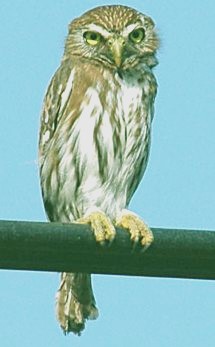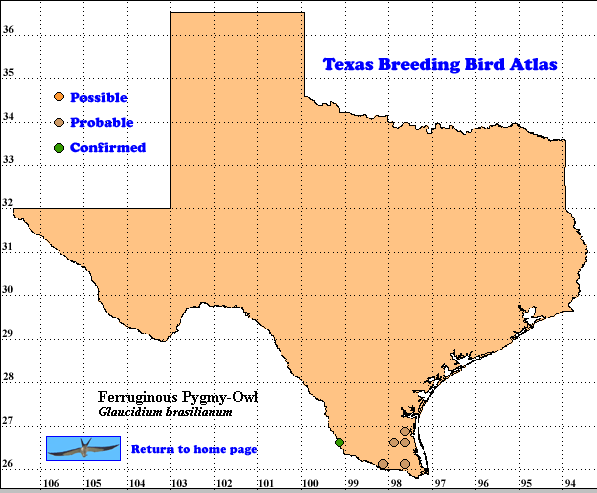Because of its small size, long tail, and atypical diurnal behavior, this owl may easily be mistaken for a passerine. When agitated, it perches with its tail cocked upward or jerking its tail from side to side. Distinctive identifying characteristics include its long dark brown barred, mainly cinnamon rufous tail, cinnamon rufous or dark brown crown with dull white streaks, and eye-like spots on the back of its head (Oberholser 1974, Proudfoot and Johnson 2000). The rufous coloration and streaked spotted crown are two of the characteristics used to distinguish this owl from the slightly smaller Northern Pygmy-Owl (G. gnoma).
DISTRIBUTION: Historically, the range of the Ferruginous Pygmy-Owl included semi-tropical lowlands in southern Arizona and southern Texas and extended south along the Atlantic and Pacific slopes through Mexico, throughout Central and South America to Chile and Argentina (Oberholser 1974, Monson and Phillips 1981, Proudfoot and Johnson 2000). This owl is usually considered the most common small owl in lowland areas of the American tropics, and from 1840-1991 was the most collected owl species in Mexico (Oberholser 1974, Enriquez-Rocha et al., 1993). Similarly, prior to 1920, Ferruginous Pygmy-Owls were considered a common residents of mesquite (Prosopis spp.) brush, ebony (Pithecellobium spp.), and riparian areas in the lower Rio Grande valley of Texas (Oberholser 1974). However, by the early 1970’s over 90% of this habitat was cleared for urban and agricultural expansion, drastically reducing the size of the known population of this species (Oberholser 1974, Monson and Phillips 1981).
During the Texas Breeding Bird Atlas (TBBA) field work in 1987-1992, 2 confirmed breeding sites were recorded in Starr County, Texas. In addition, 6 probable sites were recorded below the 27th parallel. The information provided from the TBBA suggests the Ferruginous Pygmy-Owl is extremely rare in southern Texas. Recent studies, however, have located and monitored 39 nests and placed U. S. Fish and Wildlife Service aluminum leg bands on 145 owls in Kenedy County since January 10, 1994 (Proudfoot 1996, Proudfoot and Johnson 2000). In addition, broadcast surveys conducted in Brooks and Kenedy Counties from January 26-June 14,1994 recorded 66 owls responses (Mays 1996). Information provided suggests small breeding populations of these owls may occur in similar un-sampled habitats in Brooks, Cameron, Hidalgo, Kenedy, Starr, and Willacy counties, Texas.
SEASONAL OCCURRENCE: Ferruginous Pygmy-Owls are year-round residents in southern Texas. Breeding behavior (i.e., copulation and nest site selection) may be initiated in late February and egg laying may occur April 9-early June, peaking in late April (Oberholser 1974, Proudfoot and Johnson 2000). Egg laying and hatching are asynchronous, one egg every 32-39 and 20-26 hours, respectively. Clutch size is from four-six eggs, with five the most common. Incubation is from 23-28 days, and fledging occurs 21-29 days after initial hatching (Proudfoot 1996, Proudfoot and Johnson 2000). Fledglings remain dependent on adults for about two months, so dispersal begins in late August. Interestingly, dispersal of young coincides with the seasonal full tail molt in adults.
BREEDING HABITAT: Throughout their range, Ferruginous Pygmy-Owls nest in a wide variety of habitats, from arid saguaro cactus (Carnegiea gigantea) desert to tropical rain forests (Proudfoot and Johnson 2000). In Texas, however, loss of habitat and possible lack of suitable cavities may have restricted this owl to specific areas (i.e., areas mature enough to contain potential nest cavities). For this species these areas occur in the live oak (Quercus virginiana)-honey mesquite (P. glandulosa) forest in the historic Wild Horse Desert, undisturbed “xeroriparian” mesquite woodlands south of the 27th parallel, and archaic wooded riparian areas in the Rio Grande delta (Oberholser 1974, Proudfoot and Johnson 2000). Information describing specific habitat characteristics (e.g., cavities/acre) needed to support a viable population of these owls in these areas is lacking. However, tentative results from ongoing research suggests moderate (50-75%) to dense (76-100%) understory cover is critical to the survival of young owls (GAP).
In live oak-honey mesquite forest, Ferruginous Pygmy-Owls usually nest in cavities in live oak trees >20 cm (8 in) in diameter at breast height. The most common owl nest site is an abandon or appropriated woodpecker hole, with an entrance diameter from 5-6.5 cm (2-2.5 in). Occasionally, these owls nest in cavities formed from decaying, wind damaged limbs. Cavities in both sound and dilapidated (snags) trees are used as nest sites. Nest boxes are also accepted. The above ground entrance height of nest cavities may be from 2-13 m (6-40 ft; Oberholser 1974, Proudfoot 1996). Because this species nests were located in trees within the confines of two permanently occupied hunting camps and one ranch site, we may assume a certain level of human activity is tolerated. Once fledged, young owls gravitate to areas of thick understory for about three weeks, until developing rudimentary flight. Fledglings monitored through dispersal established residence in habitat similar to their natal site (Proudfoot 1996).
STATUS: Recent studies suggest a viable population of Ferruginous Pygmy-Owls exists in Brooks and Kenedy counties, and small. populations may occur in Cameron, Hidalgo, Starr, and Willacy counties, Texas (Wauer et al., 1993, Mays 1996, Proudfoot and Johnson 2000) However, because historical data on numbers are lacking, and recent surveys were restricted to a few isolated areas, the overall status of this owl in Texas is uncertain. In February 1997 the U. S. Fish and Wildlife Service listed the Ferruginous Pygmy-Owl as endangered in Arizona and withheld listing in Texas until further research is conducted. See also Lockwood and Freeman (2004).
Text by Glenn A. Proudfoot (Posted with updates 2006).
Literature cited.
Enriquez-Rocha, P., J. L. Rangel-Salazar and D. W. Holt. 1993. Presence and distribution of Mexican owls,: a review. J. Raptor Res. 27: 154-160;
Lockwood, M. W. and B. Freeman. 2004. The TOS handbook of Texas birds. Texas A&M University Press, College Station.
Mays, J. L. 1996. Population size and distribution of Cactus Ferruginous Pygmy-Owls in Brooks and Kennedy Counties, Texas. M. S. thesis, Texas A&M University – Kingsville.
Monson, G. and A. R. Phillips. 1981. Annotated checklist of the birds of Arizona, 2nded. University of Arizona Press, Tucson.
Oberholser, H. C. 1974. The bird life of Texas. University of Texas Press, Austin.
Proudfoot, G. A. 1996. Natural history of the Cactus Ferruginous Pygmy-Owl. M. S. thesis, Texas A&M University – Kingsville.
Proudfoot, G. A. and R. R. Johnson. 2000.Ferruginous Pygmy-Owl Glaucidium brasilianum. In The birds of North America, No. 498 (A. Poole and F. Gill, eds.). The Birds of North America, Inc., Philadelphia, PA.
Wauer, R. H., P. C. Palmer and A. Windham. 1993. The Ferruginous Pygmy-Owl in southern Texas. Am. Birds 47: 1071-1075.

